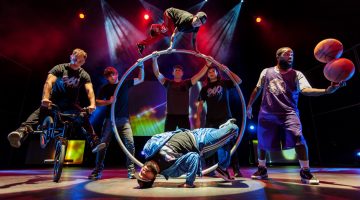What is functional training & how does it apply to me as a dancer?
by Sally Harrison from Perfect Form Physiotherapy

Read PART 1 here
Just as an athlete spends a lot of time training for competition, it is equally important that the professional dancer does the same.
The training I refer to is not taking a dance class and working on specific technique/styling, but training the body as a whole to become stronger, more robust and more reactive so it can then perform better when learning dance technique and choreography.
Remember … Dance is the epitome of skilled movement; therefore we want to train just that … movement!
Movement incorporates 3 directions: SAGITTAL (forward and back), FRONTAL (side to side) and TRANSVERSE (rotational).
Therefore, it makes sense that our exercise training also encompasses this multi-directional approach. Even our muscles have a 3D intertwining alignment. No one muscle is straight up or down, or linear or works in isolation. We are a fully connected interdependent being. Everything is connected to everything else: No start and no end.
Therefore, wouldn’t we want to train our body in such a fashion to reflect this? When planning our training, we want to think that it is always ‘body-day’ as opposed to ‘legs-and-back-day’ v ‘arms-and-abs-day’ for example.
We need to make our training sessions specific to the outcome and function that we desire … dancing! This requires us to train multiple systems. Dancing requires us to be ‘fit’ in our muscular, neural, fascial and cardiovascular systems.
We need to address:
- Stability with motion: Being rigid is not desirable for the body, and stability does not mean rigidity. We want to control our movement both in and out of our base of support and remain fluid.
- Deceleration and acceleration of movement: Have you got strength and control in both of these areas? Not only with jumps but also with smaller movements?
- Multi-directional movement: Have you looked at all 3 planes of movement?
- Control and management of gravity and ground reaction forces: How well can we align the body in space against the forces of gravity pushing us into the ground?
- Multi-directions: Use all 3 planes of movement with strength and flexibility exercises.
- Think about your relationship with gravity and ground reaction forces: Train predominantly up on your feet, this is where dancing mainly occurs. Avoid sitting on machines or spending a lot of time lying on your back pumping out thousands of reps.
- Make the movements task specific: Does your training look like dancing? Will it help your jumps, turns etc? Even exercise prescription for the jazz dancer won’t look like that for the ballet dancer, and definitely not like that for a sprinter!
Considering the last point above – exercise training for the dancer would be beneficial if performed with the feet on the ground without static machine assistance. We need to learn how to be movement-strong on the floor working against gravity.
Some Thoughts for the day …
When planning your next strength and conditioning session ask yourself … ‘Why am I doing this?’ ‘How does this help my body for dancing?’
For example, a very common exercise still practiced today is the sit-ups and abdominal crunches ‘over-used’ often by 1,000s of reps.
Q. What does this do as an exercise?
A. The movement outcome is that it shortens the front of the body, bringing us into a flexed position (bent) from neutral.
Q. How often do we need to do this position or movement in dance or daily life? Do we need to be more flexed? Do we need strength in a flexed shortened position? Do we need this strength on our back?
A. Probably not.
Long Answer: This exercise doesn’t replicate how the abdominals work. Our abdominals like to be stretched (extended and rotated). Don’t forget the added risk of internal organ prolapse is also increased with multiple ab crunches. So why do we do them?? Maybe a better option would be ‘end-range ab crunches’ over a ball or standing work that lengthens the abs with an element of rotation in the body such as high to low cable or dumbbell chops.
Another exercise that we see a lot in class and in gyms is ‘the Plank’. This is often held for minutes at a time.
Q. When do we do this in dance? When do we need to remain stiff and motionless for minutes at a time, on the floor? A. Again, probably not that often.
Long Answer: Maybe we could replace this exercise with fluid variations between plank and down-dog, with scorpion push-ups or even crawling and ‘animal flow’ drills.
In Summary: The next time we are planning on strength, conditioning and flexibility training to provide a solid base for our dance technique we want to consider the following:
Dancing is a learned, highly-skilled activity that requires many facets in working order to function harmoniously as a team. Facets such as strength, flexibility, balance and coordination. Functional training forms only one essential part of what we need to address to be successful, injury free and able to adapt and cope with any new moves and choreography. Don’t forget about the other foundational areas of good nutrition, hydration, rest and recovery, core training, flexibility and functional strength training.












